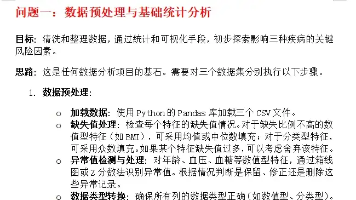自动化测试学习:pytest + request基础知识
pytest是测试框架。用于:用例发现、用例筛选、用例执行、用例报告、第三方插件。(1)安装pytest(2)使用pytest(创建用例、执行用例)基本要求:1、创建开头的py文件;2、创建开头的函数;3、在函数中(3) 启动框架、执行用例命令:pytest(4)查看参数、配置、使用说明:pytest -h(5)pytest 比较常用的参数:【 pytest-s :关闭io捕获】mark(标记用例
1、pytest 快速掌握
pytest是测试框架。用于:用例发现、用例筛选、用例执行、用例报告、第三方插件。
(1)安装pytest
pip install pytest(2)使用pytest(创建用例、执行用例)
基本要求:
1、创建test开头的py文件;
2、创建test_开头的函数;
3、在函数中使用断言
#举例:创建一个含test的py文件,如test_api.py,并在这文件中创建一个函数,函数名含test
def test_abc():
assert 1 == 2 //断言
(3) 启动框架、执行用例命令:pytest
(4)查看参数、配置、使用说明:pytest -h
(5)pytest 比较常用的参数:【 pytest -s :关闭io捕获】
mark(标记用例,被标记的用例不会再执行):@pytest.mark.skip
fixture(用例之间传递内容)
hook(改变pytest)
2、requests快速掌握
requests主要用于向接口发送请求。
把【向接口发送请求】和pytest结合起来——接口自动化
把【控制浏览器】和pytest结合起来——Web自动化
把【控制手机App】和pytest结合起来——App自动化
1、安装request
pip install requests2、使用request
(1)导入request:import requests
(2)创建一个函数,如:
import requests
def test_baidu():
resp = requests.request(
method='get', #http请求方法,必填
url='https://www.baidu.com', #接口地址,必填
data={"a":1, "b":2} , #接口参数,选填,类型有多种
json={}, #接口参数,选填,类型有多种
files={}, #接口参数,选填,类型有多种
headers={} #接口参数,选填,类型有多种
)
print(resp.status_code) #打印出接口返回的状态码
print(resp.headers) #打印出接口返回的请求头
print(resp.text)
assert resp.status_code == 200 #使用断言;断言就是对结果的判断
assert 'baidu' in resp.text3、常出现的场景
(1)表单参数
主要用在web项目:
1、参数只能是字符串;
2、请求头中包含from;
//data参数封装成字典
user_info ={
"username":"sanmu",
"password":"123456"
}
def test_api_form():
resp = requests.request(
method="post",
url="http://api.fbi.com:9225/rest-v1/login/with_form",
data=user_info, #封装成字典 :如果data参数是一个字典,则自动将其识别为表单,并自动添加请求头
)
assert resp.status_code == 200request技巧:
1)如果data参数是一个字典,则自动将其识别为表单,并自动添加请求头。
(2)json参数
主要用在各类项目中:
1、参数类型很多:字符串、数字、布尔值、空值、数组;
2、请求头中包含json;
user_info ={
"username":"sanmu",
"password":"123456"
}
def test_api_json():
resp = requests.request(
method="post",
url="http://api.fbi.com:9225/rest-v1/login/with_form",
json=user_info, #json的方式传参
)
assert resp.status_code == 200request技巧:
1)如果传递“json参数”,自动识别为json参数类型,自动添加请求。
(3)文件上传
主要用在各类项目中:
1、上传方式:body直传、表单。
2、请求头说明使用哪种上传方式。
def test_file_upload():
path = r"E:\testPycharm\python_learn\常用知识.txt" #字符串
f = open(path,'r') #文件对象
resp = requests.request(
method="post",
url="http://api.fbi.com:9225/rest-v1/upload/one_file",
files={"file": f}, # 表单上传的方式传参
)
assert resp.status_code == 200request技巧:
1)如果传递“files参数”,自动识别为表单文件上传,自动添加请求。
(4)接口关联
通过变量进行关联:创建变量、传递变量、读取变量、打印变量。
流程:
(1)请求第一个接口,得到响应;
(2)从响应中提取数据,创建变量;
(3)在第二个接口中,使用变量;
1、如何从上一个响应中提取变量:
(1)正则:re
(2)jsonpath:json接口 用jsonpath进行提取
(3)xpath
def test_token():
resp = requests.request(
method='post',
url='http://api.fbi.com:9225/rest-v1/login/with_form',
data=user_info
)
assert resp.status_code == 200
print(resp.text) #接口返回的东西打印出来:会返回token,身份凭据
#变量提取
token = jsonpatch.JsonPatch(resp.json(), '$.token')[0]
resp = requests.request(
method='get',
url='http://api.fbi.com:9225/rest-v1/auth/token_with_header',
headers={"token": token} #使用变量
)
assert resp.status_code == 200(5)参数化测试
数据驱动测试 = 参数化测试+数据文件(csv,json,yaml,execl,mysql)
3、日志、报告、插件等框架封装
pytest是一个专注用例执行的框架。如果需要增加新的功能,需要借助第三方插件。
1、I-P-O模型:
(1)输入简单:用力不是代码,只是数据
(2)输出简单:不是文本,是精美的网页
(3)处理灵活:记录日志、发送通知……
更多推荐
 已为社区贡献1条内容
已为社区贡献1条内容







所有评论(0)